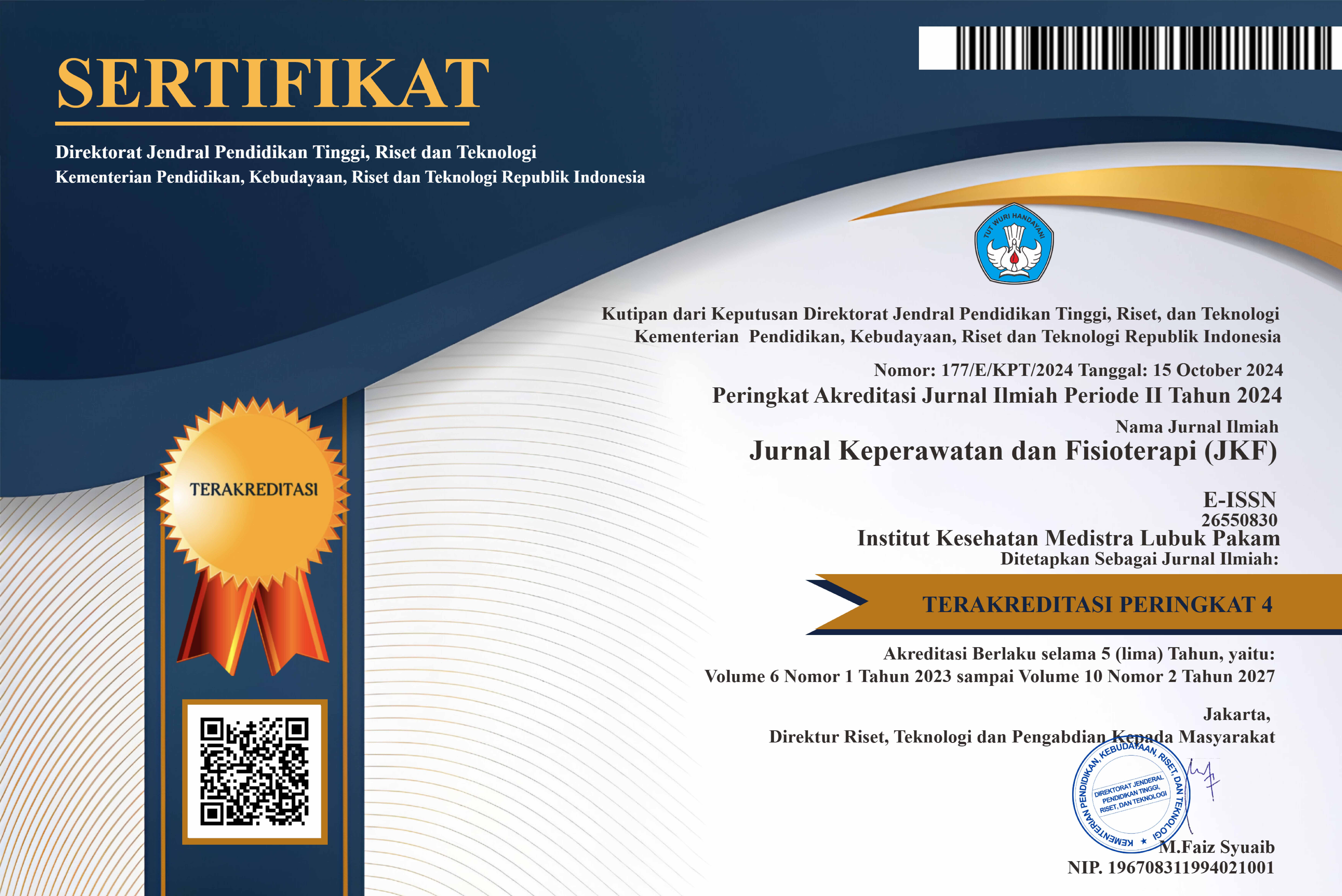Low Back Pain E/C Musculoskeletal Disorder (Msds) In Workers With Sitting Body Positions
DOI:
https://doi.org/10.35451/jkf.v6i1.1737Abstract
The muscles that are often disturbed are the muscles of the neck, arms, hands, fingers, back, waist and lower muscles. Working for a long time in a fixed position, especially sitting, will cause discomfort. This working attitude creates a static workload on the lower back muscles and causes lower back pain in workers. Respondents involved in this study amounted to 49 respondents. All respondents have the dominant activity at work, namely sitting. When viewed from the character of the respondents, as much as 77.55% of respondents had experienced muscle complaints. The most frequent muscle complaints were in the area of ??the waist (53.06%), buttocks (44.90%) and neck and shoulders (42.86%). The longer a person sits there will be stretching of the back muscles and the posterior longitudinal ligament which have the thinnest properties so that this prone area is disturbed causing pain. Suggestions for employees who sit for a long time, namely doing short sports on the sidelines of work and modifying the work environment so that the sitting position becomes ergonomic
Downloads
References
Eko Nurmianto. (2008). Ergonomi?: Konsep Dasar dan Aplikasinya (2nd ed.). Guna Wijaya.
Fatmawati, V., & Khotimah, S. (2015). Hubungan Antara Lama Duduk dan Sikap Duduk dengan Keluhan Nyeri Punggung Bawah pada Pengrajin Batik Kayu di Desa Wisata Krebet Bantul, Yogyakarta. Jurnal Fisioterapi, 15(2), 105–111. https://ejurnal.esaunggul.ac.id/index.php/Fisio/article/view/1433
Makmuriyah, & Sugijanto. (2013). Iontophoresis Diclofenac Lebih Efektif Dibandingkan Ultrasound Terhadap Pengurangan Nyeri Pada Myofascial. Jurnal Fisioterapi, 13(April 2013), 17–32.
Mayasari, D., & Saftarina, F. (2016). Ergonomi Sebagai Upaya Pencegahan Musculoskletal Disorders pada Pekerja. Jurnal Kedokteran Universitas Lampung, 1(2), 369–379. https://juke.kedokteran.unila.ac.id/index.php/JK/article/download/1643/1601
Moom, R. K., Sing, L. P., & Moom, N. (2015). Prevalence of Musculoskeletal Disorder among Computer Bank Office Employees in Punjab (India): A Case Study. Procedia Manufacturing, 3(Ahfe), 6624–6631. https://doi.org/10.1016/j.promfg.2015.11.002
Nirarya Putri, N. P., Dewi, A. A. N. T. N., Juhanna, I. V., & Sutadarma, I. W. G. (2019). The CORRELATION BETWEEN WORK POSTURE AND WORK SITTING DURATION WITH RISK OF NECK DISABILITY IN DENPASAR CITY WORKERS. Majalah Ilmiah Fisioterapi Indonesia, 7(1), 1–5. https://doi.org/10.24843/mifi.2019.v07.i01.p10
Okezue, O. C., Anamezie, T. H., Nene, J. J., & Okwudili, J. D. (2020). Work-Related Musculoskeletal Disorders among Office Workers in Higher Education Institutions: A Cross-Sectional Study. Ethiopian Journal of Health Sciences, 30(5), 715–724. https://doi.org/10.4314/ejhs.v30i5.10
Rahayu, P. T., Arbitera, C., & Amrullah, A. A. (2020). Hubungan Faktor Individu dan Faktor Pekerjaan terhadap Keluhan Musculoskeletal Disorders pada Pegawai. Jurnal Kesehatan, 11(3), 449. https://doi.org/10.26630/jk.v11i3.2221
RI, K. (2013). Riset Kesehatan Dasar: Riskesdas.
Tarwaka, & Bakri, S. H. A. (2016). Ergonomi untuk Keselamatan, Kesehatan Kerja dan Produktivitas. UNIBA PRESS. http://shadibakri.uniba.ac.id/wp-content/uploads/2016/03/Buku-Ergonomi.pdf
Walter R. Frontera, J. K. S. (2018). Essentials of Physical Medicine and Rehabilitation (4th ed.).
Wijaya, K. (2019). Identifikasi risiko ergonomi dengan metode nordic body map terhadap pekerja konveksi sablon baju. Seminar Dan Konferensi Nasional IDEC, 1, 1–9. https://idec.ft.uns.ac.id/wp-content/uploads/2019/05/ID075.pdf
Downloads
Published
Issue
Section
License
Copyright (c) 2023 Anastasia Putu Martha, Raditya Kurniawan Djoar, Ifa Gerhanawati, Atik Swandari

This work is licensed under a Creative Commons Attribution 4.0 International License.
Copyright in each article is the property of the Author.


























